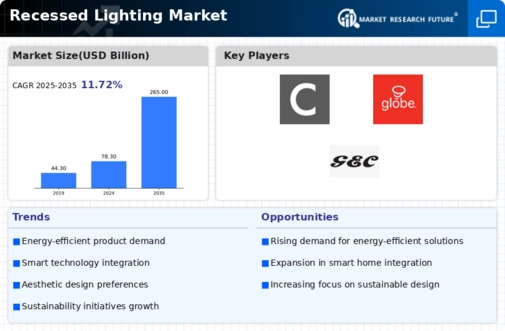Top Industry Leaders in the Recessed Lighting Market
 Recessed lighting, once relegated to basic functionality, has become a star performer in the world of interior design. But beneath this seemingly serene surface, a fierce battle for market share unfolds, with established players and innovative newcomers vying for the spotlight. Let's delve into the strategies, trends, and recent developments shaping the dynamic landscape of recessed lighting.
Recessed lighting, once relegated to basic functionality, has become a star performer in the world of interior design. But beneath this seemingly serene surface, a fierce battle for market share unfolds, with established players and innovative newcomers vying for the spotlight. Let's delve into the strategies, trends, and recent developments shaping the dynamic landscape of recessed lighting.
Strategies Lighting the Way:
-
Diversification Beyond the Downlight: Leading companies like Philips Lighting and Acuity Brands are expanding their portfolios beyond traditional downlights, venturing into track lighting, LED strips, and even smart lighting systems, catering to diverse design aesthetics and functionalities. -
Energy Efficiency Takes Center Stage: Sustainability is the new buzzword. Eaton Corporation is leading the charge by developing highly energy-efficient LED recessed lights, aligning with environmental regulations and resonating with eco-conscious consumers. -
Smart Technology Steals the Show: Innovation is the key to unlocking brilliance. Lutron Electronics is pioneering smart recessed lighting systems with voice control, app integration, and scene-setting capabilities, transforming homes into personalized light shows. -
Geographic Expansion: Emerging markets like China and India present fertile ground for growth. Legrand, for instance, has established production facilities in these regions to capitalize on the surging demand for affordable and stylish recessed lighting solutions. -
Vertical Integration: Gaining control of the supply chain is crucial. Cooper Lighting is acquiring LED manufacturers and investing in advanced production technologies, ensuring quality control, cost-effectiveness, and a competitive edge.
Factors Shaping Market Share:
-
Lighting Type Matters: From incandescent bulbs to cutting-edge LEDs, each type offers distinct advantages. LED recessed lights dominate due to their energy efficiency and longevity, while halogen lamps cater to specific design aesthetics. Osram excels at offering a diverse range of lighting technologies to meet specific needs. -
Style and Design: Aesthetics reign supreme. Manufacturers like Artemide are pushing the boundaries of design, offering sleek, minimalist fixtures, sculptural pendants, and even recessed lighting integrated with artwork, catering to diverse architectural styles and personal preferences. -
Cost Competitiveness: Price remains a crucial factor, particularly for builders and large-scale projects. Asian manufacturers often offer cost-effective options, while European and American players command premium prices for high-performance, designer recessed lighting solutions. WAC Lighting focuses on balancing affordability with quality and design. -
Technological Advancements: New dimming technologies, color-changing capabilities, and even integration with smart home systems can disrupt the market. Ketra Lighting, for instance, is pioneering biodynamic lighting systems that mimic natural daylight patterns, promoting well-being and productivity. -
Regional Trends: Cultural preferences and building regulations influence market dynamics. Japan, for example, favors compact and energy-efficient recessed lighting, while the US market leans towards larger, statement pieces. Delta Light adapts its offerings to regional trends and preferences.
Key Players:
- Osram GmbH
- Elegant Lighting Inc
- Philips Lighting Holding B.V.
- Halo Commercial, Cree Inc.
- Globe Electric
- Acuity Brands Lighting Inc
- General Electric Company
- Eterna Lighting Ltd.
- Herbert Waldmann GmbH & Co.KG
Recent Developments:
August: Acuity Brands unveils a breakthrough in LED technology that significantly increases energy efficiency and lifespan of recessed lighting, potentially reshaping the market dynamics.
September: The European Union proposes stricter regulations on lighting energy consumption, prompting manufacturers to invest in even more efficient recessed lighting solutions.
October: China announces a major infrastructure development plan, boosting demand for recessed lighting in commercial and public spaces.
November: A consortium of lighting manufacturers and interior design professionals launches a research initiative to develop standardized design and performance guidelines for recessed lighting, promoting quality and consistency across the industry.
December: A promising startup develops bioluminescent plants that can be incorporated into recessed lighting fixtures, creating a new frontier in sustainable and ambient lighting solutions.

